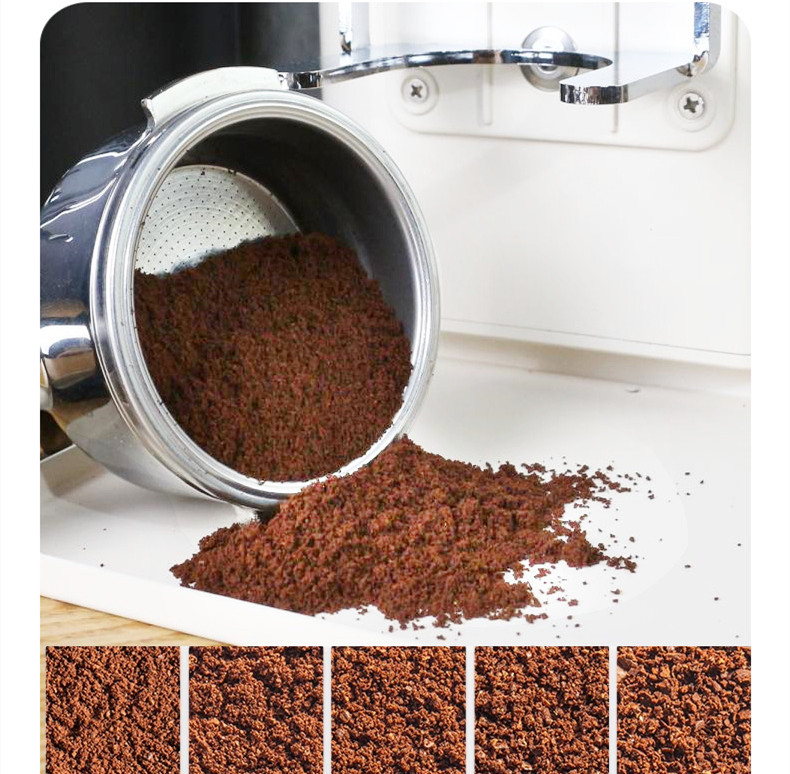The consistency of particle fineness is the core indicator for evaluating the performance of coffee grinders, directly affecting the uniformity of coffee extraction and the final flavor. The following analysis is carried out from three aspects: assessment methods, influencing factors and improvement suggestions:
First, evaluation methods
Screen mesh Analysis Method (Industry Standard)
Tools: Use standard screen sets (such as 20 mesh -80 mesh) and conduct classification tests in accordance with ASTM or ISO standards.
Step:
Weigh 10g of coffee powder and pour it into the designated sieve.
Vibrate the mechanical screen for 3 minutes and record the residual amount of each screen mesh.
Calculate the proportions of coarse powder (>600μm), medium powder (300-600μm), and fine powder (<300μm).
Result analysis: High-quality grinding machines should control the proportion of medium powder at 70%-80%, fine powder less than 15%, and coarse powder less than 5%.
Laser particle size analyzer analysis (High precision)
Principle: The particle diameter distribution is measured through laser scattering, generating parameters such as D10, D50, and D90.
Key indicators:
D50 (Median particle size) : Reflects the size of the mainstream particles;
Span value (distribution width) : Span=(D90-D10)/D50. The smaller the value, the better the consistency (for high-quality equipment, Span<1.5).
Microscopic observation (intuitive analysis)
Method: Take samples and place them under a microscope. Capture images magnified 10 times and statistically analyze the particle morphology.
Evaluation point:
Particle shape (sphericity)
Agglomeration phenomenon (lumps caused by electrostatic adsorption or grease adhesion).
Second, key influencing factors
Cutter head design
Flat Burr: It is prone to produce fine powder, with a wide distribution of coariness and fineness, and is suitable for Italian concentration.
Conical Burr: It has a low fine powder rate and good consistency, and is suitable for hand brewing and French press POTS.
Ghost Burr: The particle shape is more regular, but the cost is higher.
Motor stability
Rotational speed fluctuation: Unstable rotational speed of low-quality motors can lead to uneven particle size.
Torque output: High-torque motors (such as DC brushless motors) can reduce the phenomenon of bean jamming.
Feeding system
Single bean dosage: Excessive bean dosage can easily lead to uneven grinding.
Anti-static design: Reduces the adhesion of coffee powder to the knife head and prevents caking.
Calibration and Maintenance
Cutter head wear: After long-term use, the clearance of the cutter head increases and needs to be calibrated regularly.
Cleaning frequency: The accumulation of residual powder will affect the consistency of grinding.
Third, suggestions for improvement
Optimize the material of the cutter head: Use high-hardness steel (such as S2 tool steel) or ceramic cutter heads to reduce wear.
Add anti-static coating: Reduce the adsorption rate of coffee grounds and improve the smoothness of grinding.
Intelligent calibration system: It monitors the cutter head clearance in real time through sensors and automatically adjusts the grinding parameters.
User education: Provide a matching guide for grinding degree and extraction method (such as a complimentary brewing parameter table).
Fourth, Summary
The consistency of particle fineness is the core performance index of coffee grinders and needs to be quantitatively evaluated through tools such as screen analysis and laser particle size analyzers. Factors such as the design of the cutter head, the stability of the motor, and the feeding system all affect consistency. Users should select the appropriate grinding machine based on the usage scenario (Ruyi type concentration or hand rinse) and maintain it regularly to keep its performance. In the future, the popularization of intelligent calibration systems and anti-static technology will further enhance the consistency of grinding and promote the stable improvement of coffee quality.


